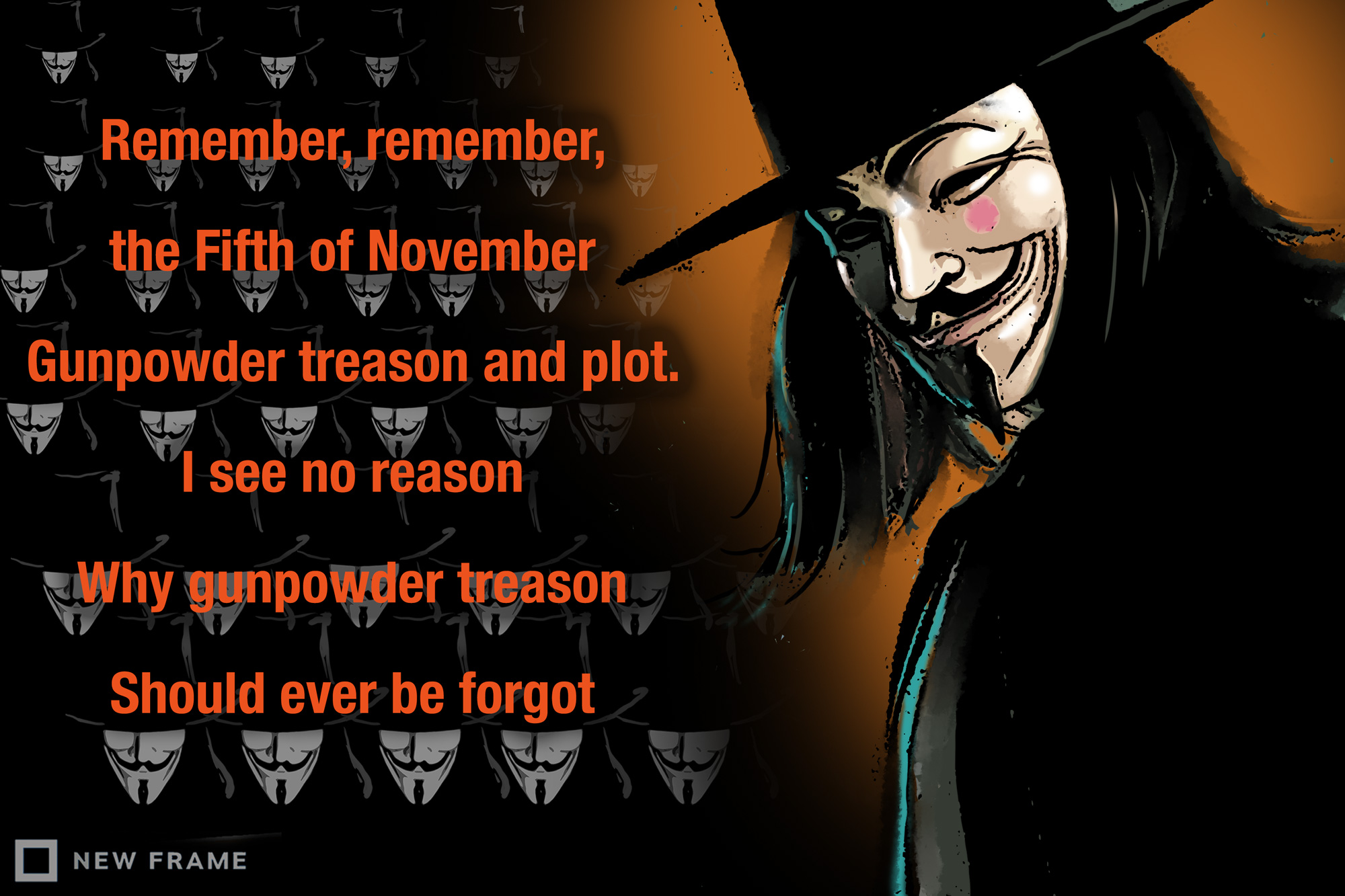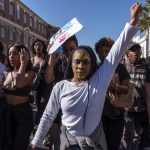Remember, remember, the fifth of November…
The mask inspired by Guy Fawkes has become a global symbol of protest, the kind that will multiply as more and more stand up to those clinging to power in an unsustainable system.
Author:
8 November 2019

In South Africa, like other former British colonies, the 5th of November used to be celebrated with fireworks and festivities as “Guy Fawkes Day” or “Bonfire Night”. The festival, now in steep decline, and, in parts of the country, outdone in the skies by Diwali, commemorates the failure of the Gunpowder Plot of 1605 from the point of view of the established order.
In an audacious plot against Protestant King James I’s repression of Catholicism, Fawkes and his Catholic co-conspirators had planned to blow up Parliament in London with the king, his heir, ministers and members of Parliament present, to seize power and allow Catholic rule in England. They were discovered, arrested, tortured and ultimately executed after the plot was revealed. The repression of Catholicism in England was intensified following the failed assassination.
Fawkes was no liberator. He had fought for the Spanish Empire, and aimed to replace an authoritarian Protestent oligarchy with an equally authoritarian Catholic oligarchy. But the audacity of the plot in which Fawkes participated has always captured the imagination and official celebrations of its crushing can easily slip into an identification with the rebels.
In 2005, the Wachowskis released the film V for Vendetta inspired by Alan Moore’s 1988 comic book series of the same name. In the years prior to the release of the film the commemoration of the plot against the English king had even faded in England. The film, and the graphic novel on which it is based, is set in an alternate, dystopian 1990s Britain which has survived a nuclear war that devastated most of the rest of the world. Amid the chaos, a white supremacist and homophobic political party seizes control of the country, eliminates its political opponents through concentration camps and runs the country as an Orwellian police state. The protagonist, who is never named, wears a Guy Fawkes mask as he attempts to bring down the fascist regime. In the book, there is a degree to which the man in the mask is a politically ambiguous character. But in the film he is, very clearly, a liberator.
Cultural icon
After the release of the film, the Guy Fawkes mask became a cultural icon and started appearing in protests across the world. It has appeared in England itself, during Occupy Wall Street in the United States, Greece, Spain, India, Thailand, Turkey, Brazil, Egypt and many other countries. Several have now enacted laws against the wearing of the mask. The most notable cases include Bahrain, the United Arab Emirates and Saudi Arabia.
The symbolism of the mask was also adopted by Anonymous, the hacktivist group that uses cyber attacks against governments they deem oppressive, political parties and multinational corporations. In 2016, a group called Anonymous Africa attacked the websites of Gupta-owned businesses, including Oakbay Investments and the now defunct ANN7 news channel and The New Age newspaper, along with those belonging to the EFF and Zimbabwe’s Zanu-PF.
Related article:
The mask has appeared again recently in protests in Hong Kong. Its meaning is not always politically clear or stable. Its anonymity allows for easy appropriation and does not enable easy definition, or participation in democratic forms of popular organisation and mobilisation. But 30 years after the fall of the Berlin Wall, and American academic Francis Fukuyama’s now infamous declaration of the end of history, the appearance of the mask is a haunting presence mocking the arrogance of the elites who imagined that, with the collapse of the Soviet Union, the world would be theirs to rule for ever.
Today, there are mass protests in Ecuador, Chile, Peru, the US, Haiti, the United Kingdom, Spain, France, the Netherlands, Guinea, Lebanon, Iraq, Syria, Indonesia and elsewhere. Some have wondered if 2020 might turn into a year like 2011, the year of the Arab Spring, Occupy and anti-austerity protests in southern Europe, or even 1968, a year of revolt by young people that rushed around much of the world.
Common threads
At the moment this is speculation. But what we can see right now is that, across the world, people are revolting. And though their ideologies, methods and convictions may be different, there are often common threads woven through this gathering revolt.
Inequality is certainly one of the central factors. In Chile, the neoliberal “miracle” of South America and one of its wealthiest countries, it was income inequality and a rise in the fares for public transport that started the protest, which is now encompassing many issues that the poorest of Chile feel have been building up for years.
Another key factor is the oligarchic form of contemporary liberalism. There is a worldwide demand for more democratic and participatory forms of rule. This includes critiques of the power of local elites, global institutions and capital. In a globalised world, the decisions made by the International Monetary Fund in Washington send fuel prices rocketing in Ecuador. In Lebanon, a decision to tax the WhatsApp messaging application contributed to the protests. Everywhere, government corruption and the collusion of big business in policy making is a common concern in the new wave of protest.
At the same time, exasperation at the lack of government action regarding climate change led millions to take to the streets in October. According to the Global Climate Strike website, more than 7.6 million people from 185 countries protested to demand immediate and appropriate action in response to the looming environmental collapse. Of course, there have been large planetary protests before that have not achieved their aims. In February 2003, millions in cities around the world protested against the looming US invasion of Iraq. The invasion, of course, went ahead.
Not impossible
But the rapidly escalating crisis of the liberal consensus established after the end of the Cold War is producing growing challenges from the Left and the Right. In recent years the Right, often inciting racism, sexism and xenophobia through social media, has stormed the hustings in many parts of the world. There is a sense, though, of a new challenge from the Left cohering in the ferment on the streets.
If the demands for more democracy and less inequality could be connected to the demand to break the power of the fossil fuel industries over our collective future, it is not impossible that the Left could begin to offer an effective challenge to both the Right and the crisis of liberalism that enabled the growth of the Right in the first place.
Related article:
The final stanza of Percy Bysshe Shelley’s 1819 poem, The Masque of Anarchy, has been read at protests across the world and is also the rallying call for Jeremy Corbyn’s Labour party in the UK: “Rise like lions after slumber, in unvanquishable number! Shake your chains to earth like dew, which in sleep had fallen on you: ye are many – they are few!”
This is a more democratic vision of resistance than that implied by the Guy Fawkes masks that continue to appear in protests. But as the temperatures rise and the cries for justice become louder, symbols of rebellion, from the burning tyres that blockade the streets of the Global South to the Guy Fawkes masks appearing in new waves of protests in cities around the world, will multiply. It is in this space – unstable, contradictory, but real – that the battle for a viable future must be waged.


